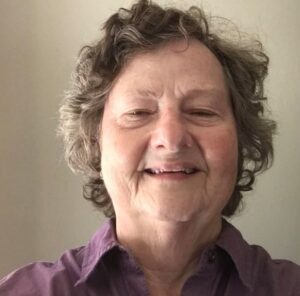 Leslie James is a retired medical librarian and worship planner. She resides, gardens and works in her studio in Wichita, Kansas. She is a member of Hope Mennonite Church.
Leslie James is a retired medical librarian and worship planner. She resides, gardens and works in her studio in Wichita, Kansas. She is a member of Hope Mennonite Church.
Whether you call them actions, traditions or rituals, congregations, much like nuclear families, have ways of celebrating, mourning or remembering together that act as treasured ways of being family. Some examples include certain ways of celebrating communion or gathering for Maundy Thursday, or what will be served at a funeral meal or given to children following their Christmas program. Usually, these action/traditions/rituals become treasured, because they, first, touched a congregation in some special way and, then, became deeper and richer each time they were shared, slowly becoming part of the very fabric and heart of the congregation. To experience them is to retell, remember and relive the presence and faithfulness of God in the past, in the present moment and to know it will be so in the future, while inviting those new to the tradition to join in fully.
Our congregation, though always ready to experience worship together differently, has a rich collection of dearly held traditions and rituals: communion on Maundy Thursday; the Christmas Eve service; experiencing Easter by entering into a still darkened, silent sanctuary that bursts into song and light at the proclamation, “He is Risen,” and ending the service with a joyous feast of special Easter breads and fruit.
This past fall, one particular action/tradition/ritual stood out in our life together as a congregation. The accumulated depth of its meaning and its importance as wordless expression was powerfully driven home. We were looking forward to the return of our pastor from sabbatical on the second Sunday in September. Dave was an avid cyclist. On the first Saturday of September, he was struck by a car, while on his morning ride, the glare of the sun obscuring his presence from the driver. He succumbed to his injuries early the next morning.
As timing would have it, his memorial service was the following Saturday, before we, as a family, would have an opportunity to gather to remember him. Our interim pastor asked if there was an action we could enter into that second Sunday of September. There was. We have a long history of remembrance, sometimes on a Sunday morning, sometimes as a special evening service. There would need to be little introduction or instruction. We knew this, and its meaning runs deep in the hearts of individuals and congregation alike. It required no words, yet would bear the weight of our raw, still wordless grief, while reminding us powerfully at its close that we were neither alone nor forsaken.
The wordless prayers of all, the presence of God among and with us, would be visible in the silence that followed.
The worship center was set simply for the ritual. The deacons were there to assist and support those who came. Grief, remembrance, and prayers filled the tera cotta dishes as worshipers silently lit candles and set them in the dishes. The prayers of each, surrounded and strengthened by the prayers of all, were made visible as the service ended. Words were not yet possible, but our tradition of remembrance allowed us to give full voice to all that was being felt.
Learn more about the Mennonite Spiritual Directors Network at mennosdn.org.
You can find links to the Spiritual Directors Network website and other congregational and ministerial resources on MC USA’s Church Vitality webpage: https://www.mennoniteusa.org/
The views and opinions expressed in this blog belong to the author and are not intended to represent the views of the MC USA Executive Board or staff.
Interested in submitting a blog for Menno Snapshots? Please see our blog guidelines here.


